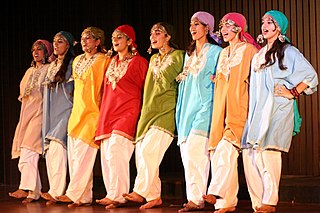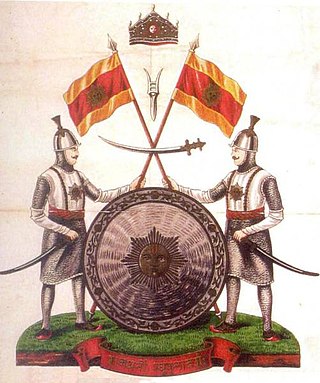Related Research Articles

Kashmir is the northernmost geographical region of the Indian subcontinent. Until the mid-19th century, the term "Kashmir" denoted only the Kashmir Valley between the Great Himalayas and the Pir Panjal Range. The term has since come to encompass a larger area that includes the India-administered territories of Jammu and Kashmir and Ladakh, the Pakistan-administered territories of Azad Kashmir and Gilgit-Baltistan, and the Chinese-administered territories of Aksai Chin and the Trans-Karakoram Tract.

The history of Kashmir is intertwined with the history of the broader Indian subcontinent in South Asia with influences from the surrounding regions of Central, and East Asia. Historically, Kashmir referred to only the Kashmir Valley of the western Himalayas. Today, it denotes a larger area that includes the Indian-administered union territories of Jammu and Kashmir, Ladakh, the Pakistan-administered territories of Azad Kashmir and Gilgit-Baltistan, and the Chinese-administered regions of Aksai Chin and the Trans-Karakoram Tract.

The Kashmiri Pandits are a group of Kashmiri Hindus and a part of the larger Saraswat Brahmin community of India. They belong to the Pancha Gauda Brahmin group from the Kashmir Valley, located within the Indian union territory of Jammu and Kashmir. Kashmiri Pandits are Hindu Kashmiris native to the Kashmir Valley, and the only remaining Hindu Kashmiris after the large-scale conversion of the Valley's population to Islam during medieval times. Prompted by the growth of Islamic militancy in the valley, large numbers left in the exodus of the 1990s. Even so, small numbers remain.

Sir Hari Singh was the last ruling Maharaja of the princely state of Jammu and Kashmir of the Dogra dynasty.

The Kashmir conflict is a territorial conflict over the Kashmir region, primarily between India and Pakistan, and also between China and India in the northeastern portion of the region. The conflict started after the partition of India in 1947 as both India and Pakistan claimed the entirety of the former princely state of Jammu and Kashmir. It is a dispute over the region that escalated into three wars between India and Pakistan and several other armed skirmishes. India controls approximately 55% of the land area of the region that includes Jammu, the Kashmir Valley, most of Ladakh, the Siachen Glacier, and 70% of its population; Pakistan controls approximately 30% of the land area that includes Azad Kashmir and Gilgit-Baltistan; and China controls the remaining 15% of the land area that includes the Aksai Chin region, the mostly uninhabited Trans-Karakoram Tract, and part of the Demchok sector.

Kashmiris are an Indo-Aryan ethnolinguistic group speaking the Kashmiri language and originating from the Kashmir Valley, which is today located in Indian-administered Jammu and Kashmir.

Bhimber is a town and the headquarters of the eponymous district in Pakistan-administered Azad Kashmir. The town and district are between the Jammu region of Indian-administered Kashmir and Pakistan proper, about 47 km (29 mi) by road southeast of Mirpur.

Pratap Singh was the Maharaja of Jammu and Kashmir, and head of the Jamwal Rajput clan of the ruling Dogra dynasty.

Jamwal is a toponymic surname for a Dogra Rajput clan of the same name from Jammu, in Jammu and Kashmir, India. They claim descent from the traditional founder of Jammu, Jambu Lochan, and there at one time some of their members were rulers of the princely state of Jammu and Kashmir, often referred to as the Dogra dynasty.

Kashmiri Muslims are ethnic Kashmiris who practice Islam and are native to the Kashmir Valley of Indian-administered Jammu and Kashmir. The majority of Kashmiri Muslims are Sunni, while Shias form a minority. They refer to themselves as "Koshur" in the Kashmiri language.

Jammu and Kashmir, also known as Kashmir and Jammu, was a princely state in a subsidiary alliance with the British East India Company from 1846 to 1858 and under the paramountcy of the British Crown, from 1858 until the Partition of India in 1947, when it became a disputed territory, now administered by three countries: China, India, and Pakistan. The princely state was created after the First Anglo-Sikh War, when the East India Company, which had annexed the Kashmir Valley, from the Sikhs as war indemnity, then sold it to the Raja of Jammu, Gulab Singh, for rupees 75 lakhs.
Islam is the majority religion practised in Kashmir, with 97.16% of the region's population identifying as Muslims as of 2014. The religion came to the region with the arrival of Mir sayed Ali shah Hamdani, a Muslim Sufi preacher from Central Asia and Persia, beginning in the early 14th century. The majority of Kashmiri Muslims are Sunni Muslims.
Miyan are Rajput clans of Jammu and Kashmir, Uttarakhand and Himachal Pradesh states in India.

Pir Budhan Shah, also called Baba Budhan Ali Shah, Peer Baba, and Sayyed Shamsuddin, was a venerated Sufi pir who held a religious discourse with Guru Nanak in Rawalpindi and later accepted Gurmat thought during the times of Guru Hargobind. He was a Sufi Muslim by birth he was born in Talwandi, the same village as Guru Nanak. He is venerated by Sikhs, Muslims, and Hindus. It is believed that he lived for around 500 years.

Jammu is a city in Indian-administered Jammu and Kashmir in the disputed Kashmir region. It is the winter capital of Jammu and Kashmir, which is an Indian-administered union territory. It is the headquarters and the largest city in Jammu district. Lying on the banks of the river Tawi, the city of Jammu, with an area of 240 km2 (93 sq mi), is surrounded by the Himalayas in the north and the northern plains in the south. Jammu is the second-most populous city of the union territory. Jammu is known as "City of Temples" for its ancient temples and Hindu shrines.

The Exodus of Kashmiri Hindus, or Pandits, is their early-1990 migration, or flight, from the Muslim-majority Kashmir valley in Indian-administered Kashmir following rising violence in an insurgency. Of a total Pandit population of 120,000–140,000 some 90,000–100,000 left the valley or felt compelled to leave by the middle of 1990, by which time about 30–80 of them are said to have been killed by militants.

A widespread agitation throughout the princely state of Jammu and Kashmir in British Raj occurred in 1931 against the Maharaja's government. The Maharaja was forced to appoint the Glancy Commission to investigate the people's concerns. Various political reforms were adopted including the introduction of the Jammu and Kashmir Praja Sabha. The movement also saw the rise of Sheikh Muhammad Abdullah as the leader of Kashmiris. The movement was funded by some well-to-do Muslim Zaildars and business houses.
The following is a timeline of the Kashmir conflict during the period 1846–1946.
Under Dogra rule, people in the princely state of Jammu and Kashmir launched several political movements. Despite ideological differences and varying goals they aimed to improve the status of Muslims in a state ruled by a Hindu dynasty.
Chitralekha Zutshi is a historian of Kashmir and an endowed chair Professor of History at the College of William and Mary, USA.
References
- 1 2 3 "Mridu Rai". Presidency University, Kolkata . Retrieved 16 September 2017.
- 1 2 "Can Kashmir be Possessed Through Maps?" (PDF). Universiteit Leiden . Retrieved 16 September 2017.
- 1 2 3 4 5 "Mridu Rai" (PDF). Presidency University, Kolkata . Retrieved 16 September 2017.
- ↑ Rai, Mridu (26 July 2004). Hindu Rulers, Muslim Subjects: Islam, Rights, and the History of Kashmir. ISBN 0691116881 . Retrieved 16 September 2017.
- ↑ Reinhardt, W.W. (2005). "Reviewed work: Hindu Rulers, Muslim Subjects: Islam, Rights, and the History of Kashmir". Choice. 42 (5): 910.
- ↑ Ganguly, Sumit (2005). "Mridu Rai, Hindu Rulers, Muslim Subjects: Islam, Rights, and the History of Kashmir". The Journal of Asian Studies. 64 (1): 234–235. doi:10.1017/s0021911805000586. ISSN 0021-9118. S2CID 161974484.
- ↑ Raychaudhuri, Tapan (2005). "Hindu Rulers, Muslim Subjects: Islam, Rights, and the History of Kashmir. By Mridu Rai (London: G. Hurst & Co., 2004), 450 pp. Price PB £19.95 ISBN 1–850–65701–7. Languages of Belonging: Islam, Regional Identity, and the Making of Kashmir. By Chitralekha Zutshi (London: G. Hurst & Co., 2004), 348 pp. Price HB $35.00 ISBN 8–178–24060–2". Journal of Islamic Studies. 16 (3): 402–405. doi:10.1093/jis/eti170. ISSN 1471-6917.
- 1 2 3 "Princeton University 250th Anniversary Celebration Collection". Library Finding Aids. Princeton University. Retrieved 11 November 2012.
- ↑ "Hindu Rulers, Muslim Subjects". Hurst Publishers . Retrieved 16 September 2017.
- ↑ Long, Roger D. (2004). "Hindu Rulers, Muslim Subjects: Islam, Rights, and the History of Kashmir". History: Reviews of New Books. 33 (1): 34–35. doi:10.1080/03612759.2004.10526435. ISSN 0361-2759. S2CID 142926771.
- ↑ Ogletree, Aaron Peron (2006). "Mridu Rai, Hindu Rulers, Muslim Subjects: Islam, Rights, and the History of Kashmir". International Journal of Hindu Studies. 10 (1): 119–120. doi:10.1007/s11407-006-9014-4. ISSN 1022-4556. S2CID 142710255.
- ↑ Bhatta, Chandra D (2006). "Reviewed work: Mridu Rai, Hindu Rulers, Muslim Subjects: Islam, Rights, and the History of Kashmir". International Affairs. 8 (3): 650–651.